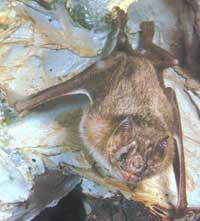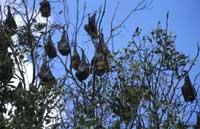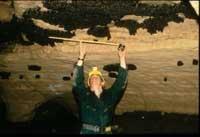Vampires are not so terrifying

There are three species of bats called vampires, and none live near Euskal Herria; the truth is that they all live in the American continent: South America, Central America and North America. Therefore, there is not much to see here bat vampires. But in the area where the vampires live they are not easy to see, since they usually walk at night
However, it is not long that they have received the name of vampire, since the origin of the word vampire is found in the legends of Romania and its adjoining territories. In them appear curved and terrifying characters that fed human blood. And since these special bats also feed on blood sorption, they have been given that name: the bats vampires.

But these bats do not drink human blood at all, but from cattle and some birds. And they are much smaller than those huge fictional bats: They barely reach 40 grams, and with very wide wings they have about 35 centimeters maximum.
Moreover, the scientific name of many bats refers to vampires. Examples of this are the genera Vampyrum, Vampyressa, Vampyrodes and Vampyrops, but these bats are not blood fermenters, but have a diet similar to that of the rest of bats.
Where do they come from?
Of course, it is not common for bats to drink blood. Many are fruit trees and others feed on insects. And it is believed that vampires evolved from insectivorous bats. There are several theories to explain the origin of these special bats. Some believe that the ancestors of these bats ate mammalian parasitic insects, bloodthirsty parasites, while others ate insects that grow in the wounds of large mammals and their larvae, which gradually became fond of blood consumption.
Bat vampires belong to the group of American bat strands (Phyllostomidae). His face is very special, with large and flattened end, very sharp incisions to pierce the skin of the cattle and very large ears.
These large ears help the bat ‘see’ in the dark. In fact, it uses a system called ecolloquiation to detect the environment: the sound, the ultrasonic wave, in particular, detects objects from the environment thanks to the echo emitted and heard. The bat uses this system to detect the dam at night.

In the case of the vampire bat, the prey is usually a sleeping cow. The flying bat is known, but the vampire approaches the cow on the ground. Unlike most bats, the vampire adapts well to the ground and not just runs it. To do this, it makes force with arms in the form of wings (compared to the race style of the other animals, the way of running this bat is funny) and, for the little one, it is very fast, the researchers have measured a speed of one meter per second.
A meal but essential
As we said, the cow approaches the ground and selects a blood vessel from the leg. The area where the blood vessel is located is warmer than the rest of the skin, through which the bat detects. Once the blood vessel is located, it pricks the teeth to pierce the skin and absorbs the blood circulating through the duct.
The bat needs about twenty grams of blood to satisfy it. The cow does not bleed, much less. Blood accounts for about 10% of the weight of the animal, so a cow of about four hundred kilos contains forty kilos of blood, which can be considered a nonsense to lose twenty grams.
The problem should be that not the cow, but the bat, all that blood just enters that tiny body. In addition, some components of the blood are more nutritious than others, so the bat, as the blood is sucked, separates the plasma into the kidneys and expels it with urine to the outside. This eliminates at least a little weight and will cost you less flying home.

The vampire usually doesn't do all night out, at least if he has had the fortune to feed himself, he returns in two hours; he hangs from head to head and begins to digest. However, after passing from one night to another, the full gut does not always return. Experts have calculated that in one of every twenty-five exits the vampire returns fasting, a higher percentage in young bats and much higher in those who die hunger.
These bats cannot resist the three-day fast, but if they are skillful and feed almost every night they can live twenty years.
The customs of bats vampires have aroused the curiosity of many experts. The better we know, the less afraid we will have the vampires.
Published in 7K.
Buletina
Bidali zure helbide elektronikoa eta jaso asteroko buletina zure sarrera-ontzian











